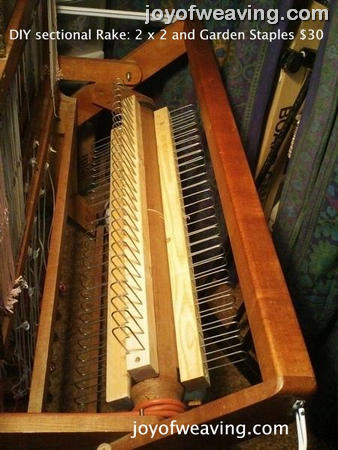 This is a bundle of woven yardage (the first 2 panels) of the Mountain Cucumber Coverlet.
This is a bundle of woven yardage (the first 2 panels) of the Mountain Cucumber Coverlet.
Treadle Beads (on Steroids)
There are so many treadle changes with this pattern, that I needed 4 rows of beads to fit them all in.
The
photo above is from last April when I began weaving on this epic
coverlet. It shows the 4 rows of beads on top in "resting position."
For smaller patterns, I used a string on top of the beater, but for this, we used metal rods and wooden truck tires for beads. They are thinner than regular round beads and the hole is larger, and I can get more on the rod. There are 4 rods for this project.
I have them labeled A-B-C-D with markers (a red bobbin) signalling the end of each movement / motif change.
Each bead tells me what treadle to push in the correct sequence, so I don't have to struggle with trying to read it on a piece of paper. The beads are easy to see, and pushing them over is much more in line with the movement / feeling of weaving. I did a video a few years ago to explain how it works. Although, my technique is better now! These days I know to pull the beater bar in the center for an even beat at the fell line. [We learn as we go!]
Eureka! It's Working: Weaving the Red and Black Circle Scarf on the Loom
- This video explains how to "program" the beads.
New Video Demonstrating the Bead System for Tracking Pattern Treadles on the Floor Loom
[This photo is from the back of the loom, in case things look reversed.]
I
start with row A and move it down to the beater bar. In the photo
above, I'd already moved onto the B-row. The ends of the rod are
attached with hair ties. If I have to break for any reason, I mark my
place in the sequence with a little clip. So far, this has been working
out marvelously!
When I started, my body was sore after weaving so long. Since then, I have learned to pace myself -- I weave for 90 minutes, then take a break and weave another 90 minutes. That seems to work out well for me now. It's good exercise, moving arms and feet.
There are a few "tricks" to help make sure I'm on track, making panels that will match up when it comes time to seam them together into the full-size coverlet.
One is to keep track of what you did on a piece of adding machine tape. Inch-by-inch I kept track of each movement in all 7 blocks of panel 1. You don't let the paper tape roll onto the cloth beam, but roll it up by itself so you can use it to make sure you're on track for panels 2, 3, and 4. So far so good. I'm within a 1/4 inch of my targets.
The other is to keep track of the length of each panel with a 120-inch measuring tape. This is pinned to the right side of the cloth, "as the flowers grow." I know that each block is about 15 inches long. And I'm keeping track of where that falls in each panel. So far so good!
PHOTO
I've found that I need to use a temple to keep the width of the woven cloth closer to the width of the warp through the reed. I don't want it to shrink up too much. As it is, the only strings that are breaking now are at the edges / selvedges, but that easily fixable.
So far, I
have woven 3 practice blocks --mostly to learn the pattern, and develop a
steady beat, and consistent 15-inch block. I have 1 panel of 7 blocks
woven, and I just finished 3 blocks into Panel 2.
Things I'm keeping track of:
How often I change bobbins (blue for pattern weft; white for tabby)
Where each days weaving ends ... Am I on target for where I expected to be? [So far so good!]
Today's weaving seemed to go exceptionally well. The time flew by, and it felt good! I feel good! Not sore or tired at all.
Braille for your feet!
A few weavers recommended marking the treadles with rubber bands (I used hair ties because they are more durable) so that you can feel them with your feet. I know that the hair ties are on Treadles 2 and 4, so I've learned to feel for them if I know I'm supposed to be pressing even-numbered treadles. I tried it a few weeks ago, and it worked great! I didn't have to do any un-weaving that day! And it seemed like I saved a fair amount of time looking down to make sure I had the right treadle.
The photo above shows a similar system on the new 8-shaft loom. The 4-shaft loom on which I am doing the coverlet project has a lot of cotton lint from the cotton warp and tabby underneath it. I decided to spare you that untidiness in order to demonstrate the basic idea. I put a hair tie on each and every treadle. If I didn't need it, I pushed it up and out of the way.



















